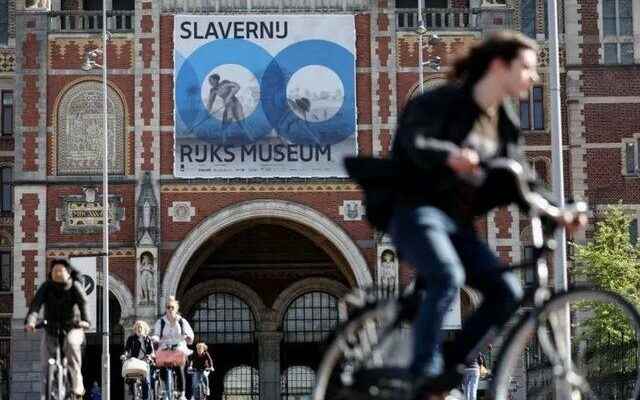Dutch Central Bank (DNB) Governor Klaas Knot has apologized for the bank’s role in its history of slavery.
The bank has announced that it will provide financial support for conflicts to reduce the effects of the past of slavery in the coming years.
The state government of North Holland was also the first to apologize for its history of slavery.
The Dutch government, on the other hand, has not yet apologized for the country’s history of slavery, despite official recommendations.
The Advisory Board of the Slavery Past Dialogue Group, which advises the Dutch Ministry of the Interior, recommended that the state make a formal apology for its past practices of slavery.
However, on the “Day of Breaking the Chains” (Keti Koti), which is held annually on July 1st to commemorate the anniversary of the abolition of slavery in the Netherlands, this expected apology from the government did not come.
The expected apology came from the Dutch Central Bank, while the government asked for “at least until autumn to make a decision on this sensitive issue”.
DNB Chairman Klaas Knot apologized for the bank’s role in the history of slavery during the national memorial service for the abolition of slavery in Amsterdam.
Emphasizing that he apologized to all descendants of enslaved people in the Netherlands, Suriname, Bonaire, Sint Eustatius and Saba, Aruba, Curaçao and Sint Maarten, Knot said, “I apologize to everyone who was reduced to skin color because of the personal preferences of my predecessors.”
Central Bank Governor Konot said that the stories he heard about that period “hurt him”.
‘The bank’s founding capital is linked to slavery’
In a research report published in February, it was determined that the Dutch Central Bank was closely related to slavery, which had an important place in the country’s history from its establishment in 1814 to 1863.
According to the 2020 investigation into the DNB’s connection to the history of slavery, the bank’s start-up capital was provided by entrepreneurs directly linked to “plantation slavery”, which included the coffee, cocoa, rubber and sugarcane trades.
According to Kami publisher NOS, about 30 percent of the products offered to the Central bank as collateral for loans consisted of goods produced by enslaved persons. In addition, some of the bank’s founders and managers had large personal interests in slavery.
Fund will be created
The Dutch Central Bank has announced that a fund will be created over the next 10 years to provide financial support for projects that will help reduce the impact of the bank’s history of slavery.
These projects will be implemented in the fields of education, health and information sharing. The bank will also provide a one-off 5 million euro for educational projects such as the National Slavery Museum and a related information centre.
However, the central bank, which sees financial compensation for past losses as the government’s problem, will therefore not pay financial compensation.
First time apology from a state
Alongside the Central Bank, the Royal Commissioner for the province of North Holland, Arthur van Dijk, also apologized for the province’s role in slavery.
It is the first time in the Netherlands that a province has apologized for its history of slavery.
“This is not a matter of identifying individuals as criminals, but of recognizing by the Dutch State the suffering caused by slavery,” said the Advisory Board of the Slavery Past Dialogue Group, advising at the government’s request.
Reminding that the cities of Amsterdam, Rotterdam and Utrecht apologized, the Board emphasized that the state should take the same step.
According to Prime Minister Mark Rutte, this is a complex situation. “The question is whether you can hold people alive today accountable to the past,” Rutte explained.
Other government partner parties, on the other hand, favor an official apology. According to Dutch media, the Dutch government is willing to apologize to the descendants of slaves in Suriname and the Caribbean in the long run.
However, the government needs some time for this and first wants to have a comprehensive discussion about the current consequences of slavery.
Dutch slavery history
The Netherlands was one of the world’s largest slave traders, especially in the 17th century, called the “Golden Age”. The Dutch West India Company (WIC), the second largest transporter of slaves from Africa to the Americas, became interested in the slave trade in Africa when it seized part of Portuguese-dominated Brazil in 1630.
In 1637, the WIC established dominance in West Africa, again in Portuguese-occupied Ghana, creating the base for the slave trade. Of the 12 million Africans sold into slavery between the 15th and 19th centuries, the Dutch transported about 550,000 to 850,000 of them across the Atlantic.
Although slavery was outlawed in Western Europe, slave traders continued transatlantic slavery. Losing Brazil again to Portugal in 1654, the Dutch made Curaçao in the Caribbean an important station in the slave trade.
According to studies, Dutch traders were responsible for half of all slave transports to the New World between 1650 and 1675. The Dutch were selling enslaved Africans to Spanish, English, Portuguese and French traders.
The slave trade is not limited to Africa. It is estimated that the Dutch enslaved approximately 1 million 135,000 people in Asia as well.
